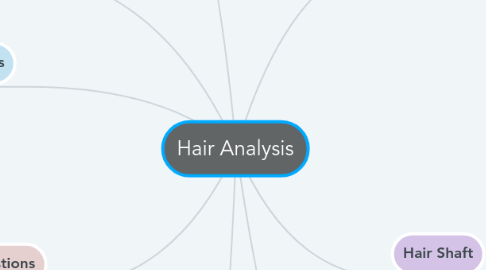
1. Medulla Patterns
2. Process Used to Visualize Scales
2.1. 1. paint clear fingernail polish on a glass slide 2. when the polish begins to dry, place a hair on the polish 3. when it is almost dry, lift off the hair 4. let slide dry completely 5. observe the scale imprints
3. Medulla Patterns
3.1. Intermittent (not found in humans)
3.2. Fragment
3.3. Continuous
3.4. Stacked (not found in humans)
3.5. Absent
4. Medullary Index
4.1. diameter of medulla/diameter of hair (measured in mm)
4.1.1. Human hair: MI generally <1/3
4.1.2. Animal hair: MI generally >1/2
5. Hair Growth
5.1. Stage 1: Anagen
5.1.1. Hair is actively growing; 5 years
5.1.2. Will have follicle tag if yanked out
5.1.2.1. contains nuclear DNA (indivdual evidence)
5.2. Stage 2: Catagen
5.2.1. Hair decreasing in growth; 2-3 weeks
5.2.2. Appears elongated as root shrinks
5.3. Stage 3: Telogen
5.3.1. Getting ready to push hair out; 2-6 months
5.3.2. Root has club like look
5.4. Hair grows .4mm a day or 1 cm per month
6. Comparisons/Questions
6.1. Hair can:
6.1.1. - help place a suspect at a scene - indicate race of a suspect - exclude a suspect or perpetrator
6.1.2. It cannot prove a suspect has committed a crime
6.2. Questions:
6.2.1. - color and length - distribution, shape and color intensity - scale type of cuticles - preserve or absence of medulla - medullary pattern or index - dyed hair in cuticle and cortex - root age of hair/follicle tag - mitochondrial DNA
7. Coronal
8. Hair Shaft
8.1. Cortex
8.1.1. Inner layer
8.1.2. Contains air sacs called cortical fusi and melanin
8.1.3. Gives hair its shape and color
8.1.4. Can contain mitochondrial DNA
8.2. Medulla
8.2.1. Inside layer; running down center of cortex
8.2.2. Not always visible; have different types of patterns
8.3. Cuticle
8.3.1. Outermost covering; made of overlapping scales
8.3.2. Point towards tip of the hair
8.3.3. Differ among animals
9. Cuticle Scale Patterns
9.1. Coronal
9.2. Spinous
9.3. Imbricate
10. Hair Collection/Toxicology
10.1. Collection
10.1.1. 50 full-length hairs from all along the scalp; 24 full length pubic hairs
10.2. Toxicology
10.2.1. Collected from multiple locations on body
10.2.2. Advantages
10.2.2.1. - easy to collect and store - is externally available - provide history of drug use or evidence of poisoning

